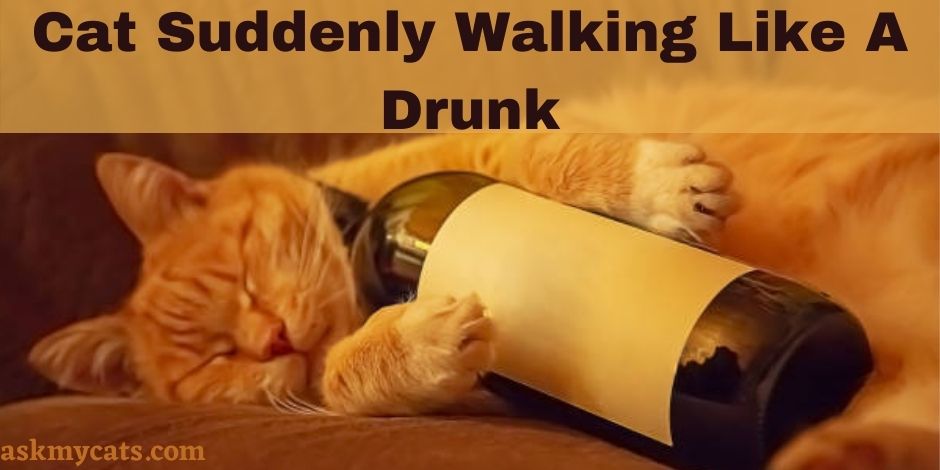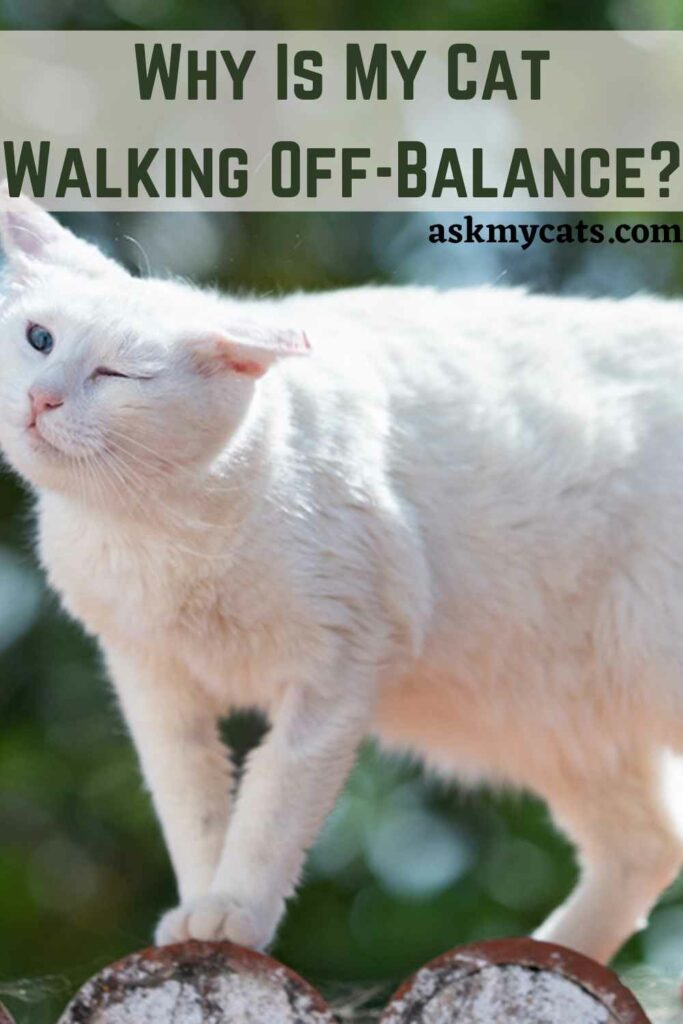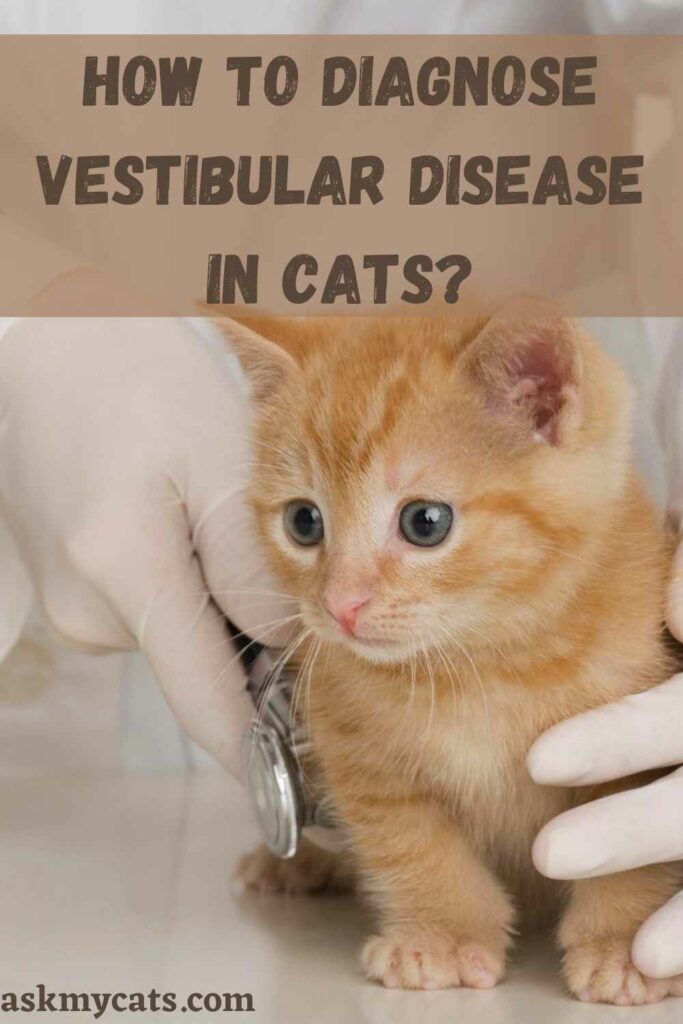It’s unnerving to see your once-graceful cat stumble around with his head tilted and eyes flickering madly.
If you have seen this in your cat, you must have wondered why your cat is suddenly walking like a drunk?
The reason behind your cat suddenly walking like a drunk could be that she is suffering from vestibular disease. Loss of balance can occur when a disease or injury disrupts the vestibular apparatus in the inner ear. The vestibular apparatus control your cat’s balance and coordination.
This article will talk about why your cat is walking like a drunk and how you can cure it.


Give Your Cat the Perfect Day
Get the Free Ebook!
Why Is My Cat Walking Like He’s Drunk?
Your cat may be walking likes he’s drunk because he is suffering from an inner ear infection.

An inner ear infection can cause vertigo in a cat. A cat that stumbles, walks with stiff legs or shakes its head frequently may have cerebellar hypoplasia, a brain disease that affects muscle control and movement.
Cats contract this disease while still in the womb or if they are malnourished or poisoned.
Ataxia, a disease with similar symptoms, also causes a loss of balance.
Kittens are especially susceptible to ataxia. It is brought on by an infection, trauma, or a disease such as cancer.
If your cat starts to stumble, wobble back and forth, or fall down, you must first protect them from further harm.
Keep your cat indoors and away from stairwells and bodies of water. Then, consult with your veterinarian and start recording the time and date of each fall.
The veterinarian will examine your cat, their blood and urine will be tested for infection or disease, and an X-ray or ultrasound will be requested.
If your cat has an inner ear infection, it will be treated with antibiotics, which will most likely cure his dizziness.
However, neither cerebellar hypoplasia nor some types of ataxia are curable. Instead, you and your veterinarian will devise a strategy for dealing with these.
The good news is that these conditions do not worsen with age. Poor balance isn’t painful, and your cat can live happily ever after with a bit of assistance from you.
You can help keep your cat safe by keeping them indoors and providing easy access to food, water, and a litterbox. And, as always, lavish your cat with affection.
Why Is My Cat Walking Off-Balance / Wobbly?
The reason behind your cat walking off balance / wobbly could be that she is suffering from ataxia.

Sensory (proprioceptive), vestibular, and cerebellar ataxias are the three clinical kinds of ataxia.
Changes in limb coordination occur in all three types, although vestibular and cerebellar ataxia also affect head and neck movement.
Ataxia is a disorder characterized by a sensory impairment that causes limb, head, and/or trunk lack of coordination.
When the spinal cord is gently squeezed, sensory (proprioceptive) ataxia develops.
Misplacing the feet is a common external indication of sensory ataxia, which is often accompanied by a gradual weakening as the condition progresses.
Lesions can cause sensory ataxia in the spinal cord, brain stem (the bottom part of the brain near the neck), or cerebral areas.
The vestibulocochlear nerve relays balancing information from the inner ear to the brain.
Damage to the vestibulocochlear nerve can result in head and neck position changes because the affected cat may experience a mistaken sense of movement or have hearing issues.
Leaning, tipping, falling, or even rolling over are examples of outward symptoms. Changes in eye movements, sensory impairments, leg weakness (all or one-sided), various cranial nerve indications, and lethargy, stupor, or coma are all common central vestibular signs.
Changes in mental state, vertical eye movements, sensory impairments, and leg weakness are not examples of peripheral vestibular symptoms.
Uncoordinated motor activity of the limbs, head, and neck, taking huge steps, stepping awkwardly, head tremors, body tremors, and torso swaying are all symptoms of cerebellar ataxia.
There is a deficiency in motor activity performance and strength preservation.
What Are The Symptoms And Causes Of Ataxia?
Symptoms and causes of ataxia are: –
1. Symptoms and Types
- Weakness of the limbs: May affect one, two, or all of the limbs/ May affect only the hind legs or the legs on one side of the body
- Tilting head to one side
- Trouble hearing – non-responsive to being called to at normal voice pitch
- Stumbling, tripping over, swaying
- Excessive drowsiness or stupor
- Changes in behavior
- Abnormal eye movements – may be due to false feelings of movement, vertigo
- Lack of appetite due to nausea (a symptom of motion sickness from loss of internal equilibrium [balance])
2. Causes
1. Neurologic
- Cerebellar
- Degenerative: Abiotrophy (prematurely the cerebellum loses function)
- Anomalous: Underdevelopment secondary to perinatal infection with panleukopenia virus in cats and A cyst located near the fourth ventricle
- Cancer
- Infectious – feline infectious peritonitis (FIP)
- Inflammatory, unknown causes, immune-mediated
- Toxic
2. Vestibular – central nervous system (CNS)
- Infectious: Feline infectious peritonitis (FIP), rickettsial diseases
- Inflammatory, unknown causes, immune-mediated
- Toxic
3. Vestibular—Peripheral nervous system
- Infectious: Middle ear and Fungal
- Diseases of unknown cause
- Metabolic
- Cancer
- Traumatic
4. Spinal Cord
- Degeneration of the nerve roots and spinal cords
- Vascular: Loss of blood to the nervous system due to blockage of blood vessels by a blood clot
- Anomalous: Spinal cord and vertebral malformation and spinal cyst
- Cancer
- Infectious
- Traumatic
5. Metabolic
- Anemia
- Electrolyte disturbances – low potassium and low blood sugar
How To Diagnose Vestibular Disease In Cats?
Vestibular disease in cats can be diagnosed by a physical exam that is usually performed to check your cat’s overall health.

Vestibular illness symptoms could be caused by another disorder, such as an inner ear infection or a head injury.
A physical checkup is frequently performed to assess your cat’s overall health.
This comprises a neurological examination as well as an otoscopic (ear) examination.
Expect to be questioned about the cat’s medical history as well as present symptoms.
If your veterinarian detects spinal cord illness, limit or restrict your cat’s activity.
If you can’t restrict your cat’s movements even if you don’t have a diagnosis of spinal cord disease, cage rest may be an option.
This is especially important for climbers, as they may fall and further harm themselves. Keep an eye on your cat’s stride for signs of developing dysfunction or weakening, and contact your veterinarian right once if it gets worse.
You’ll need to provide your veterinarian with a detailed history of your cat’s health, including the development of symptoms and any incidences that may have led up to this problem.
Standard tests, such as a blood chemical profile, a complete blood count, a urinalysis, and an electrolyte panel, will be ordered by your veterinarian.
Your veterinarian may do a series of tests to rule out other problems or look for an underlying reason for your cat’s lack of balance.
To rule out conditions that could cause a loss of balance, your veterinarian may conduct blood tests, urine tests, and ear cultures.
An MRI, spinal tap, and head x-rays may be required to rule out any traumas or illnesses that may have caused the problem.
The tests also enable your veterinarian to determine whether the loss of balance has resulted in a more serious condition, such as an injury from falling.
These tests could include:
- Measurement of blood glucose levels (sugar levels in the blood)
- Chemistry tests to evaluate kidney, liver, and pancreatic function, as well as sugar levels
- A complete blood count (CBC) to rule out blood-related conditions
- Electrolyte tests to ensure your pet isn’t dehydrated or suffering from an electrolyte imbalance
- Urine tests to screen for urinary tract infection and other diseases and to evaluate the ability of the kidneys to concentrate urine
- A thyroid test to determine if the thyroid gland is producing too much thyroid hormone
- Ultrasound examination of the abdomen to rule out tumors.
The detection of any concomitant conditions or underlying causes will determine the course of treatment. If there isn’t a known cause, your veterinarian will provide supportive treatment for your dizzy cat while he recovers.
The good news is that most occurrences of this disease resolve rapidly, with cats healing without the need for medication.
Cat Suddenly Walking Like Drunk Treatment
Cat Suddenly Walking Like Drunk Treatment includes: –
1. Treating the Underlying Cause
An ear infection, tumor, or toxic exposure can all induce a loss of balance. If this is the case, your veterinarian will treat the condition’s underlying cause.
Your veterinarian may prescribe antibiotics to treat an illness or medication toxicity. The underlying cause determines treatment options.
2. Treating Idiopathic Vestibular Disease
If your cat’s loss of balance or vestibular condition is idiopathic, your veterinarian will focus on treating the symptoms and providing comfort.
Because dizziness might make your cat lose their appetite or vomit, your veterinarian may prescribe medicine to address vomiting, nausea, and motion sickness.
During rehabilitation from this illness, your cat may require assistance with feedings, hydration administration, and shifting positions.
To avoid harm when trying to rise up or walk, your cat may be kept in a cage rest in a well-padded area. The good news is that the symptoms normally go away and don’t come back.
Recovery Of Balance Loss In Cats
Recovery of balance loss in cats could be done by: –
- Although your veterinarian can treat the underlying cause or symptoms of your pet’s loss of balance, it is still necessary to schedule a follow-up appointment after the treatment. A follow-up visit allows your veterinarian to ensure that the underlying cause has been treated or eliminated. Your veterinarian will also ensure that your cat has not become ill or injured as a result of the loss of balance.
- From aiding with feedings to providing medication, it’s critical to follow your veterinarian’s recommendations. You may need to keep your cat on cage rest until the symptoms have totally disappeared. When it’s time to stop the treatment, your veterinarian will let you know.
- If discovered early, the underlying reason may be treated, and idiopathic vestibular sickness normally goes away in a short time.
Frequently Asked Questions
What does a cat stroke look like?
It’s frightening to see your cat lose their ability to walk, appear inebriated, fall over to one side, tilt its head, or act neurologically inappropriately (e.g., seizure). Other signs that look like “acute strokes” in cats include sudden imbalance—and falling over to the side.
Why is my cat suddenly off balance?
Ataxia, a disorder with comparable symptoms, causes a loss of balance as well. Kittens are especially susceptible to ataxia. Infection, trauma, or a condition such as cancer can cause it. Protect your cat from further harm if they begin to stumble, wobble back and forth, or fall down.
What does a seizure look like in a cat?
A cat may exhibit behavior changes such as pacing, circling, yowling, or vomiting just before having a seizure (known as an aura or pre-ictal activity). Your cat will be disoriented after the seizure (post-ictal) and may display temporary paralysis in one or more legs, seem blind, vomit, or exhibit other behavioral changes.
Final Words
If your cat has an inner ear infection, it will be treated with antibiotics, which will likely result in your cat’s dizziness being resolved. Cerebellar hypoplasia and some kinds of ataxia, on the other hand, have no cure. Instead, you and your veterinarian will devise a strategy for dealing with them.
The good news is that these illnesses do not worsen as your cat gets older. Poor balance isn’t painful, and with a little help from you, your cat can live happily ever after.
Continue to keep your cat indoors with easy access to food, water, and a litterbox to help keep them safe. And, as always, show your cat a lot of affection.
For any unanswered questions, reach out in the comments section.

I found this page because of an incident with my cat last night. Sam, my 16 year old mix breed, stumbled a few times and then fell over. He also cried, as if frightened or upset. I held him for a moment and his limbs felt stiff. The entire incident, as frightening as it was, seemed to pass quickly. He was back to normal within fifteen minutes. He had a similar incident about eight or nine years ago – same symptoms and same short duration.
It sounds like what you’ve described here, so we’ll keep an eye out for any further symptoms. Thanks for laying out everything so neatly and understandably on this page.
Hi there,
This is very informative post indeed. Thank you so much.
I would like to ask about something as my cat experienced some of described symptoms. We straight anyway went to the vets and they suspecting this to be cat epilepsy but I am quite sceptical.
My cat is about 3 year old. He is quite active cat and love his going outs. Today while he was laying on the bed, suddenly his eyes were going back and forth, from one side to another and then he tried to jump from the bed all fell over. He nearly fell over from the stairs. He lost balance for about 10 minutes and then came back to normal. This happened again later in the day but he had little milder symptoms but del disbalanced for little longer. Because be scratch one of his ears on the regular basis and I see sometimes that he drop his ear like half way showing little discomfort I would think this could be more like vestibular disease. We would like to get second opinion from the other vet as well. Also, his bloods came back perfectly normal and stool sample was OK as well. Physical examination did not shown any abnormalities as well.
I would appreciate any advise please.
Consult your vet for any expert advice
My cat had a few seizures last night and now can’t walk straight. Other than that I don’t see anything else wrong. I thought it was a snake bite but I haven’t seen any bit Mark’s. I don’t have the money to take him to the vet. What can I do
Home remedies can not stop a cat from having seizures. Still, what you can do is to remain calm, place your pet in a safe spot and make sure he is getting whatever he wants whenever he wants (to ease his discomfort).